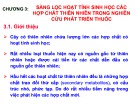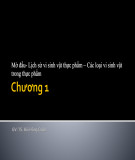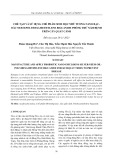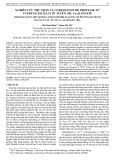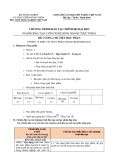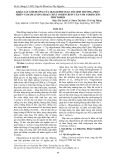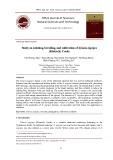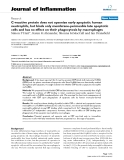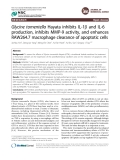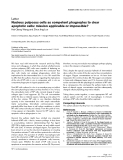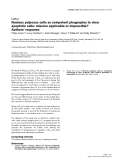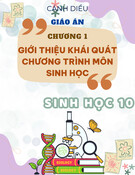HPU2. Nat. Sci. Tech. Vol 03, issue 01 (2024), 88-94
HPU2 Journal of Sciences: Natural Sciences and Technology
journal homepage: https://sj.hpu2.edu.vn
Article type: Research article
Study on isolating, breeding, and cultivation of Xylaria nigripes (Klotzsch) Cooke
Thi-Thuong Ngoa, Xuan-Phong Onga, Dinh-Viet Nguyenb, Thi-Hang Doanc, Bich-Phuong Vud, Viet-Hong Laa,*
aHanoi Pedagogical University 2, Vinh Phuc, Vietnam bMinh Dai High School, Phu Tho, Vietnam cNhan Chinh Secondary School, Hanoi, Vietnam dDich Vong Secondary School, Hanoi, Vietnam
Abstract
The Xylaria nigripes fungus is one of the medicinal materials that was used in traditional medicine. Extracts from the mycelium and fruiting bodies of the X. nigripes showed protecting cells, preventing DNA damage, and reducing the programmed death cell rate. In this study, the fruiting bodies of the X. nigripes were collected to isolate, propagate in the liquid medium, and then cultured to induce the fruiting body formation in the rice medium. The results showed that the X. nigripes was successfully isolated on PDAY (Potato Dextrose Agar Yeast Extract) medium, and the mycelium and spore of the X. nigripes had unique characteristics of the species. The biomass of X. nigripes grew well in a liquid nutrient medium containing 20g glucose, 1g MgSO4.7H2O, 2g KH2PO4, and 5g peptone, reaching the best mass after 21 to 28 days. Using an initial cultured liquid of X. nigripes to culture on rice medium, fruiting bodies were formed and developed after 14 days of culture. This result could potentially be applied to the production of X. nigripes biomass via mycelium and fruit bodies for application in medicine.
Keywords: Xylaria nigripes, research, propagation, cultivation, isolation
1. Introduction
Xylaria nigripes (Klotzsch) Cooke) is a valuable medicinal mushroom belonging to the Xylariaceae family. In traditional medicine, X. nigripes was used to treat insomnia and injuries, and X. nigripes was also utilized as a nerve tonic [1]–[5]. Water extract and 70% ethanol extract of X.
https://doi.org/10.56764/hpu2.jos.2024.3.1.88-94
Received date: 24-10-2023 ; Revised date: 08-3-2024 ; Accepted date: 15-3-2024
This is licensed under the CC BY-NC 4.0
88
* Corresponding author, E-mail: laviethong@hpu2.edu.vn
HPU2. Nat. Sci. Tech. 2024, 3(1), 88-94
nigripes mycelium showed effective protective effects on PC12 cells against H2O2-induced cell damage by inhibiting lactate dehydrogenase release, reducing DNA damage, restoring mitochondrial membrane potential and preventing aberrant apoptosis through upregulation of Bcl-2 and downregulation of Bax and caspase 3, ethanol extract in addition to better neuroprotective effects, also has higher antioxidant activity by scavenging 2,2-Diphenyl-1-picrylhydrazyl radicals, inhibiting lipid peroxidation and reducing energy [6]–[12]. Recently, two new compounds, xylariamino acid A and new phenethyl ester, were isolated and identified in X. nigripes. The isolated compounds neuroprotective effects against PC12 cell damage caused by hypoxia and glucose. Furthermore, the compound phenethyl ester can significantly reduce the rate of apoptotic cells [13], [14].
In Vietnam, the Xylariaceae family of the Ascomycetes class has been studied. New research focuses on the taxonomic level, initially isolating a number of species [15]. However, research on biomass acquisition has not been fully reported. We conducted research on isolating and collecting X. nigripes biomass to gather initial data on its growth and development characteristics.
2. Materials and methods
2.1. Materials
Fungal source: X. nigripes specimens were collected from the traditional pharmacist in Muong
Khuong district - Lao Cai in May 2023.
Research Media: Potato Dextrose Agar Yeast Extract (PGAY) includes 200g/L potato extract,
20g/L glucose, 1g/L MgSO4.7H2O, 2g/L KH2PO4, 2g/L yeast extract, 20g/L agar (pH 6.5).
2.2. Methods
2.2.1. Isolation of the X. nigripes
Fungal isolation was an optimized protocol for isolating single spores of fungi [16]. Particularly, collected fruit bodies in the wild were pre-cleaned with distilled water for 2-3 times, then soaked and surface sterilized in 90o alcohol for 15 minutes to remove dirt and mold. A sterilized knife was used to cut the fruit bodies in half and placed explants in size 1x1 cm2 on a Petri dish containing PGAY medium. Culture conditions: dark incubation at temperatures from 22-25oC
Morphological characteristics of the colony and mycelium were observed after coloring with
methylene blue staining by using a microscope (Primo star, Carl Zeiss, Germany).
2.2.2. Propagation of X. nigripes liquid
Use the pure cultured mycelial mycelium for liquid propagation as described with some modified components of media [13]. Particularly, three formulas were constructed, including CT1: 20g/L glucose + 1g/L MgSO4.7H2O + 2g/L KH2PO4 + 5g/L yeast extract + 5g/L peptone; CT2: 20g/L glucose + 1g/L MgSO4.7H2O + 2g/L KH2PO4 + 5g/L peptone; CT3: 20g/L glucose + 1g/L MgSO4.7H2O + 2g/L KH2PO4 + 2g/L yeast extract + 5g/L peptone (pH 6.5), the cultured conditions were at 22-25oC temperature and at 100 rpm shaking [17], [18]. Evaluation of the characteristics of cocci colonies (KLC) after 14 days of culture.
2.2.3. Cultivation of X. nigripes
After growing stably in a liquid culture, the mycelium of the X. nigripes was grown on a solid medium. To prepare the solid medium, rice grain was washed, soaked for 12 hours in cold water, then
https://sj.hpu2.edu.vn
89
HPU2. Nat. Sci. Tech. 2024, 3(1), 88-94
boiled, placed in a glass jar steamed at 90oC for 60 minutes, cooled, and cultured. After being cultured, the seeds were raised at a temperature of 22-25oC, and the growth rate was observed and collected at 7, 14, and 21 days.
2.2.5. Data analysis
All results were analyzed using the Excel program according to statistical parameters such as mean value, and standard deviation [19]. Characteristics of the mycelium and fruit bodies are described in specialized terms.
3. Results and discussion
3.1. Isolation of the X. nigripes
The results of isolating fungi from fruit bodies on the PGAY medium are shown in Figure 1. Colonies cultured on PDAY medium were initially white and fluffy (Figure 1a and b). After 14 - 21 days of culture, a black, cylindrical, tapering, upward-facing, unbranched, curved stromal structure forms, measuring 90 mm x 1 - 2 mm (Figure 1c). The conidiophores structure was upright, densely packed, and transparent (Figure 1d, e, and f). The short vesicle was symmetrical, vase-shaped, 20µm - 48µm × 1.8 µm -5.8 µm. Conidia are spherical, 3.2 µm - 3.5 µm × 2.1 µm - 2.9 µm (Figure 1f).
https://sj.hpu2.edu.vn
90
Figure 1. Growth and development of X. nigripes on the PGAY medium. Mycelium grows on solid medium after (a) 7, (b) 4, and (c) 21 days. (d)-(f) mycelium, sporangia under microscope (X40), arrow indicates location of spore sac.
HPU2. Nat. Sci. Tech. 2024, 3(1), 88-94
3.2. Propagation of X. nigripes liquid
3.2.1. Effect of fluid culture medium composition on growth of X. nigripes
Nutritional composition was an important factor affecting the entire growth process of fungus varieties. Previous research utilized a compressed air-activated fermentation method to collect X. nigripes biomass in a medium consisting of 2% brown rice flour and 0.5% malt extract in distilled water. The resulting mycelium showed many valuable biological activities [6]. In this study, the influence of the nutritional composition of the culture medium on mycelial growth was investigated. The fungus was cultured in three nutritional media containing common ingredients such as glucose, MgSO4·7H2O, KH2PO4, and peptone, the results were shown in Table 1 and Figure 2.
Table 1. Effects of nutritional media on the growth of X. nigripes cocci colonies (KLC).
Formula KLC characteristics KLC size (mm) KLC density Biomass (g/100ml)
CT1 1.05 + 0.02
CT2 0.93 ++++ 4.76
(+) Indicates the amount of KLC from 10-30/ml of solution; (++) Indicates the amount of KLC from 31- 60/ml of fluid; (+++) Indicates the amount of KLC from 61-90/ml of fluid; (++++) Indicates the amount of KLC from 91-120/ml of fluid; (+++++) Indicates the amount of KLC greater than 120/ml of fluid.
CT3 1.02 +++ 1.26 Clear fluid, KLC has short tendrils and sparse density Clear fluid, KLC has short tendrils and thick density Clear fluid, KLC has short tendrils, medium density
Figure 2. Effects of nutritional environment on the growth and development of X. nigripes.
According to the data in Table 1 and Figure 2, it showed that the growth rate of the mycelium system was different between the formulas. The mycelium growth rate was fastest in formula CT2, followed by formula CT3, and was the lowest in formula CT1. From the table above, it may also be seen that the size and characteristics of cocci colonies were quite uniform. This result is also consistent with the findings of the study [11], X. nigripes could grow on a simple nutritional medium containing fructose, yeast extract, MgSO4, nitrogen source, and carbon source.
3.2.2. The biomass accumulation of mycelium
After choosing a suitable propagation medium, we continued to monitor the accumulation of X. nigripes biomass on CT2 liquid medium. An amount of biomass from the original medium was transferred to a new CT2 nutrient medium and the biomass accumulation was monitored for 4 weeks
https://sj.hpu2.edu.vn
91
HPU2. Nat. Sci. Tech. 2024, 3(1), 88-94
with a 7-day biomass determination interval, the results are shown in Figure 3. From the chart above, it can be seen that the accumulation of X. nigripes grows slowly initially and then rapidly increases from day 7 to day 21. From day 21 to day 28, mycelium biomass gradually decreases, with a significant decline observed from day 28 to day 31. This decrease in biomass could be attributed to the gradual depletion of nutrients in the medium as fungal biomass increases. Additionally, the mycelium may transition from the growth phase to the equilibrium phase, resulting in aging. Moreover, it's worth noting that the liquid form of lingzhi mushroom biomass contains substances that prevent damage to PC12 cells due to factors such as oxygen deprivation, glucose shortage, and the presence of phenethyl ester compounds, which significantly reduce apoptotic cell death [13]. Therefore, the CT2 medium is suitable for cultivating X. nigripes biomass, and biomass collection is recommended during the period from day 21 to day 28 after cultivation.
Figure 3. Diagram of dynamical growth and development of mycelial biomass in CT2.
Table 2. Fruit body development speed after 7-14-21 days.
Fruiting body characteristics
Time (days) 7 14 Fruiting body height (mm) 0 25
21 30
3.3. Cultivation of X. nigripes
According to previous research [20], extracting fractions from the fruiting bodies of oleaginous mushrooms using n-Hexane solvent has the best protection against cytotoxicity caused by lipopolysaccharide, More detailed analysis identified two important compounds: ergosterol-3β-ol and ergosterol peroxide. In this study, after cultivation in a liquid medium, the fungus was transferred to a rice nutrient medium for further cultivation to induce fruiting. The results are shown in Table 2 and Figure 4.
From day 1 to day 7, the mycelium grows very slowly, forming fungal filaments that stick to the rice grains. However, from day 7 to day 21, the mycelium grows rapidly in both height and diameter. However, from the 21st day onwards the mushroom fruiting body does not grow in height and begins to lose water and reduce the diameter of the stem.
https://sj.hpu2.edu.vn
92
28 30 Thin, black, without white silk surrounding it Black with white silk surrounding from root to tip Black, white silk gradually disappears from root to tip, starting to reduce in size and diameter Black, white silk gradually disappears from root to tip, shrinking
HPU2. Nat. Sci. Tech. 2024, 3(1), 88-94
Figure 4. Growth and development of the X. nigripes variety on secondary nutrient medium. Mycelial development after a) 7, b) 14, and c) 21 days. Fruiting bodies develop a distinct white color in b) and c).
4. Conclusions
The X. nigripes fungus was successfully isolated on PDAY medium on agar plates. The mycelium and sporangia of X. nigripes were observed to be characteristic of the species. The mycelium system grows well in a nutritional environment consisting of 20g glucose, 1g MgSO4·7H2O, 2g KH2PO4, and 5g peptone. The fungal biomass grew well and maintained a stable size after 21 to 28 days after culture. Fruiting bodies were formed and developed on rice medium after 14 days of culture. It is important to continue to investigate the active ingredients in the fruiting bodies and biomass of X. nigripes.
References
[1] Y. Lin et al., “Efficacy and safety of Wuling capsule, a single herbal formula, in Chinese subjects with insomnia: A multicenter, randomized, double-blind, placebo-controlled trial,” J. Ethnopharmacol., vol. 145, no. 1, pp. 320-327, Jan. 2013, doi: 10.1016/j.jep.2012.11.009.
[2] R. D. Divate and Y.-C. Chung, “In vitro and in vivo assessment of anti-inflammatory and immunomodulatory activities of Xylaria nigripes mycelium,” J. Funct. Foods., vol. 35, no. 1, pp. 81-89, Aug. 2017, doi: 10.1016/j.jff.2017.05.027. [3] K. Sd et al., “Ethnopharmacology of Solanum nigrum: A review,” World J. Curr. Med. Pharm. Res., vol. 4, no. 4, pp. 48-52, Aug. 2022, doi: 10.37022/wjcmpr.v4i4.223.
[4] C. Mouffouk, S. Mouffouk, S. Mouffouk, and H. Haba, “Traditional use, phytochemistry and pharmacological properties of the genus onopordum,” Curr. Chem. Biol., vol. 17, no. 2, pp. 124-139, Jun. 2023, doi: 10.2174/2212796817666230102092008.
[5] M.-N. Lai, H.-C. Hsu, and L.-T. Ng, “Safety assessment of the standardized aqueous extract from solid-state cultured Xylaria nigripes (Wuling Shen) in rats,” Clin. Phytoscience, vol. 7, no. 1, p. 44, May. 2021, doi: 10.1186/s40816-021-00281-5.
[6] R. D. Divate, P. -M. Wang, C.-C. Wang, S.-T. Chou, C.-T. Chang, and Y.-C. Chung, “Protective effect of medicinal fungus Xylaria nigripes mycelia extracts against hydrogen peroxide-induced apoptosis in PC12 Int. J. Immunopathol. Pharmacol., vol. 30, no. 1, pp. 105-112, Mar. 2017, doi: cells,” 10.1177/0394632017695280.
[7] C. Huang, Y. Lin, H. Su, and D. Ye, “Forsythiaside protects against hydrogen peroxide-induced oxidative stress and apoptosis in PC12 Cell,” Neurochem. Res., vol. 40, no. 1, pp. 27-35, Jan. 2015, doi: 10.1007/s11064-014-1461-5.
https://sj.hpu2.edu.vn
93
[8] M.-C. Hung et al., “Biological Activities of the polysaccharides produced from different sources of Xylaria nigripes (Ascomycetes), a Chinese Medicinal Fungus,” Int. J. Med. Mushrooms, vol. 17, no. 2, pp. 141-150, Jan. 2015, doi: 10.1615/IntJMedMushrooms.v17.i2.50.
HPU2. Nat. Sci. Tech. 2024, 3(1), 88-94
[9] Z. Zhao et al., “Xylaria nigripes mitigates spatial memory impairment induced by rapid eye movement sleep deprivation,” Int. J. Clin. Exp. Med., vol. 7, no. 2, pp. 356-362, Feb. 2014, [Online]. Available: https://www.ncbi.nlm.nih.gov/pmc/articles/PMC3931588/. [10] W.-F. Peng et al., “The anti-depression effect of Xylaria nigripes in patients with epilepsy: A multicenter randomized double-blind study,” Seizure, vol. 29, pp. 26-33, Jul. 2015, doi: 10.1016/j.seizure.2015.03.014.
[11] J.-Z. Chen et al., “Effects of medium components and culture conditions on mycelial biomass and the production of bioactive ingredients in submerged culture of Xylaria nigripes (Ascomycetes), a Chinese medicinal fungus,” Int. J. Med. Mushrooms, vol. 16, no. 5, pp. 431-447, Jan. 2014, doi: 10.1615/intjmedmushrooms.v16.i5.30.
[12] J. H. Jeong et al., “Water extract of mixed mushroom mycelia grown on a solid barley medium is protective against experimental focal cerebral ischemia,” Curr. Issues Mol. Biol., vol. 43, no. 1, pp. 365–383, Jun. 2021, doi: 10.3390/cimb43010030. [13] H. Long, S. Zhou, L. Li, J. Li, and J. Liu, “Two new compounds from the fungus Xylaria nigripes,” Molecules, vol. 28, no. 2, p. 508, Jan. 2023, doi: 10.3390/molecules28020508.
[14] J. Li et al., “Xylarinaps A-E, five pairs of naphthalenone derivatives with neuroprotective activities from doi: nigripes,” Phytochemistry, 112729, 2021, 186, Jun. vol. no. 2, p. Xylaria 10.1016/j.phytochem.2021.112729.
[15] T-T-H. Nguyen and A. Ngo, “Preliminary data on the family Xylariaceae Tul. and C. Tul. in Ru Linh, Vinh Linh district, Quang Tri province,” in The fifth national scientific conference on The scientific report on Ecology and Biological Resources, Hanoi, Vietnam, 2013, pp. 481-487. [16] K. Zhang, S. Yuan-Ying, and L. Cai, “An optimized protocol of single spore isolation for fungi,” Cryptogam. Mycol., vol. 34, no. 4, pp. 349-356, Dec. 2013, doi: 10.7872/crym.v34.iss4.2013.349.
[17] D. Nirmal, S. Teraiya, and P. Joshi, “Liquid culture system: An efficient approach for sustainable micropropagation,” Curr. Agric. Res. J., vol. 11, no. 1, pp. 28-42, May. 2023, doi: 10.12944/carj.11.1.03. [18] I. C. Rusu and M. B. Nicolcioiu, “Research on obtaining liquid mycelia from pleurotus spp. strains and testing their fruiting potential,” Curr. Trends Nat. Sci., vol. 11, no. 21, pp. 418-427, Jul. 2022, doi: 10.47068/ctns.2022.v11i21.046. [19] V-M. Nguyen, V-H. La, and X-P. Ong, Methods in plant physiology, Hanoi National University Publishing House, Hanoi, Vietnam, 2013.
https://sj.hpu2.edu.vn
94
Int. J. Med. Mushrooms, vol. 19, no. 10, pp. 915-924, [20] C. -C. Liaw, S. -J. Wu, C. -F. Chen, M. -N. Lai, and L. T. Ng, “Anti-inflammatory activity and bioactive constituents of cultivated fruiting bodies of Xylaria nigripes (Ascomycetes), a Chinese medicinal fungus,” (in eng), Jan. 2017, doi: 10.1615/IntJMedMushrooms.2017024404.

